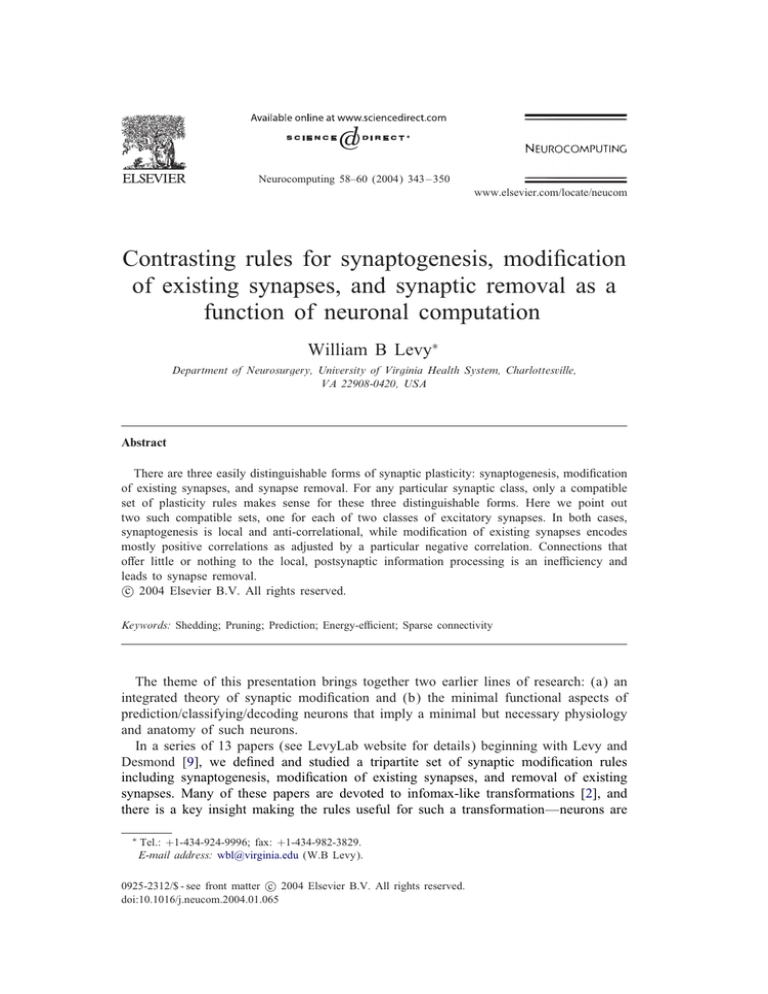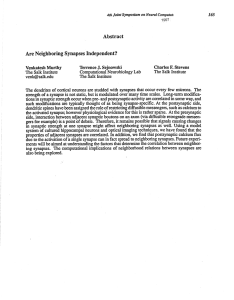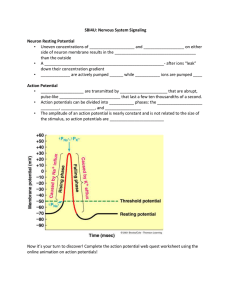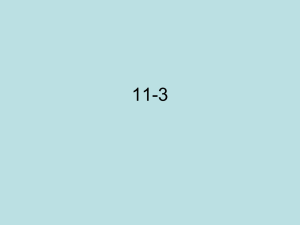Contrasting rules for synaptogenesis, modi#cation function of neuronal computation
advertisement

Neurocomputing 58–60 (2004) 343 – 350
www.elsevier.com/locate/neucom
Contrasting rules for synaptogenesis, modi#cation
of existing synapses, and synaptic removal as a
function of neuronal computation
William B Levy∗
Department of Neurosurgery, University of Virginia Health System, Charlottesville,
VA 22908-0420, USA
Abstract
There are three easily distinguishable forms of synaptic plasticity: synaptogenesis, modi#cation
of existing synapses, and synapse removal. For any particular synaptic class, only a compatible
set of plasticity rules makes sense for these three distinguishable forms. Here we point out
two such compatible sets, one for each of two classes of excitatory synapses. In both cases,
synaptogenesis is local and anti-correlational, while modi#cation of existing synapses encodes
mostly positive correlations as adjusted by a particular negative correlation. Connections that
o2er little or nothing to the local, postsynaptic information processing is an ine3ciency and
leads to synapse removal.
c 2004 Elsevier B.V. All rights reserved.
Keywords: Shedding; Pruning; Prediction; Energy-e3cient; Sparse connectivity
The theme of this presentation brings together two earlier lines of research: (a) an
integrated theory of synaptic modi#cation and (b) the minimal functional aspects of
prediction/classifying/decoding neurons that imply a minimal but necessary physiology
and anatomy of such neurons.
In a series of 13 papers (see LevyLab website for details) beginning with Levy and
Desmond [9], we de#ned and studied a tripartite set of synaptic modi#cation rules
including synaptogenesis, modi#cation of existing synapses, and removal of existing
synapses. Many of these papers are devoted to infomax-like transformations [2], and
there is a key insight making the rules useful for such a transformation—neurons are
∗
Tel.: +1-434-924-9996; fax: +1-434-982-3829.
E-mail address: wbl@virginia.edu (W.B Levy).
c 2004 Elsevier B.V. All rights reserved.
0925-2312/$ - see front matter doi:10.1016/j.neucom.2004.01.065
344
W.B Levy / Neurocomputing 58–60 (2004) 343 – 350
most useful when carrying a genetically prede#ned amount of information and innervated in a biased random manner that produces a relatively small fractional connectivity
to each neuron. The appropriate synaptogenesis rule can guarantee this information constraint and, as well, a connectivity in which each neuron only receives a small random
fraction of the total available inputs [8]. Because activity levels are also being guaranteed, these rules can also produce neurons that #re at an energy-e3cient information
rate [6].
In parallel with this work on synaptogenesis, there was also ongoing work describing certain neuronal computations by CA1 hippocampal pyramidal cells [4,5,7]. In
particular, a cell much like a CA1 pyramid of the hippocampus (and as well, like a
neocortical pyramid that has a main apical dendrite and which receives di2erent classes
of inputs distally and proximally on the apical dendritic branches) is a candidate for
performing as a prediction/classifying neuron. (A prediction neuron essentially forecasts
a classi#cation prior to the event occurring and a classi#cation neuron is essentially
a retrodicting neuron where a feature set is used to decide on the existence or not
of a named category. Such a neuron can also be a decoder.) Fig. 1 illustrates, with
the two distinct apical dendritic compartments, the anatomical description of such a
pyramidal-type neuron. Compartment 1 (C1) is the most distal compartment. Functionally it is an information transforming compartment, and at this functional level,
it resembles an entire information transforming neuron (illustrated as a dentate gyrus
granule cell to the right of C1 in Fig. 1). The inputs that excite C1 essentially de#ne the set of events that the pyramidal neuron is constructed (self-constructed) to
recognize, classify, decode, or predict.
Compartment 2 (C2) is devoted to predicting something about the excitation of C1.
That is, we hypothesize that the synaptic excitation of C2 generates predictions or
classi#cations in the absence of the C1 event being predicted or classi#ed. Thus, C2
combines feature information to predict about the “named category” or event de#ned by
compartment 1. A critical characteristic that distinguishes the two compartments is the
associative synaptic modi#cation rule of the existing synapses. In C1 the rule depends
only on events produced by the inputs to C1. Thus, the modi#cation is unsupervised
or self-supervised. On the other hand, the associative synaptic modi#cation rule for
an existing synapse in C2 depends upon the coactivity between this synapse and a
postsynaptic excitation arising out of compartment 1. Thus, the synaptic modi#cation
here is supervised.
Although not absolutely critical, we will assume that the C1 excitation is distally
thresholded and call this Zj ∈ {0; 1}. Likewise thresholding the excitation of C2 produces ZI j ∈ {0; 1} where this variable is the predicted value of Zj .
Here, we now consider what forms of synaptogenesis and synapse removal are
compatible with such a synapse and function. At all times biological plausibility is
our utmost concern (see [7,9] for details illustrating the relevant biology). The most
interesting idea is that synaptogenesis is a decreasing function of postsynaptic
excitation.
Table 1 emphasizes the similarities between the two sets of synaptic plasticity rules.
In particular, we hypothesize that synaptogenesis is, fundamentally, anti-correlational
in a way that complements the positive correlational encodings produced by modi#ca-
W.B Levy / Neurocomputing 58–60 (2004) 343 – 350
345
Fig. 1. The computational distinction between a prediction neuron and an information transforming neuron
has morphological correlates. The distal tuft of the prediction neuron corresponds to the entire dendritic #eld
of the information transforming neuron.
tion of the synapse once formed. Synaptogenesis is invigorated when the postsynaptic
neuron is failing to do something it was designed to do. In one case (C1), the hypothesized function is carrying enough information, in the other case (C2), the function is
successful prediction.
A second aspect of synaptogenesis is the local principle. It is not possible to maintain
speci#city between pre- and postsynaptic elements if temporally coactive elements are
too widely (more than 1 or 2 m) separated in space. That is, if there is a multiplicity
of presynaptic elements and a multiplicity of postsynaptic elements as actually exist in
the brain, activity-based, chemically di2using signals being passed between pre- and
postsynaptic structures will inevitably be confused once the distances between pre- and
postsynaptic structures are too large and the times between presynaptic and postsynaptic
coactivation is too long. Thus, although we posit correlational statistics are encoded at
synapses, this only occurs after synaptogenesis.
346
W.B Levy / Neurocomputing 58–60 (2004) 343 – 350
Table 1
General principles for excitatory synaptic plasticity in neocortex
Synaptogenesis
Modi#cation of existing
synapses
Synapse removal
Stochastic process
Anti-correlational
Deterministic process
Correlational and
anti-correlational
Stochastic process
Excitatory synapses falling below a
Receptivity for new innervation Stores statistic(s) in synaptic
is negatively correlated with a weights, wij , for presynaptic in- minimum value are wasteful and
put i and postsynaptic neuron j should be removed
certain aspect of postsynaptic
excitation
Independent contributions by
Lw(t + 1) ˙
pre- and post (pre = i, post = j) f(post j (t)) ∗ g(prei (t); wij (t));
Ai —presynaptic avidity
Rj —postsynaptic receptivity
Prob(of new synapse ij) ˙
Ai (t) ∗ Rj (t)
Prob(removal ij)
0 if wij (t) + Lwij (t + 1) ¿ c
=
¿ 0 otherwise
wij ¿ 0;
f(post i ) ¿ 0;
(c is some nonnegative constant)
g ( ), over a restricted range, can Lw can take on negative or
be positive, negative, or zero
positive rules
The general principles of synaptogenesis noted in Table 1 reNect this local principle
(that is, avoid action at a distance). As a result, the presynaptic rule depends on something about the presynaptic structure and the postsynaptic rule depends on something
local to the postsynaptic structure. These separate events would each control distinct
biological growth processes that, when multiplied together, can be interpreted as a probability (e.g., surface area, di2usable growth factor, binding sites, or random growth).
Thus, physical separateness produces an independence-like idea which is reNected in
the multiplication (see Table 1).
Again referring to Table 1 and its generic descriptions, synapse removal is an ef#ciency mechanism. That is, a synapse on postsynaptic neuron j that makes little or
no contribution to the computation performed by j is ine3cient; it wastes space and
energy, and in Nature such ine3ciency is a demand for synapse removal. As we are
limiting the discussion here to excitatory synapses (and obviously inhibitory synapses
do carry information and would require a very di2erent set of synaptic plasticity rules),
we can see one clear requirement for synapse removal: excitatory synapses that are
driven to a value of zero or less should be removed. In fact it might even be argued,
they should be removed when they are at a value proportional to uncorrelated or less.
Surely once they are driven to a value below uncorrelated, they should no longer be
excitatory synapses and should, if anything, make some contribution to the inhibition
of the cell j.
Tables 2 and 3 detail some of the speci#c di2erences that distinguish these synaptic plasticity rules as a function of whether the compartment is designed for e3cient representational information capacity, i.e., C1, or whether the function is prediction/classi#cation as in C2.
W.B Levy / Neurocomputing 58–60 (2004) 343 – 350
347
Table 2
Compartment 1 (C1) of Prediction Neuron
(≡ Information transforming neuron)
vs.
Prediction Compartment (C2)
(a) Comparing synaptic weights
−
+
wij
(1−wij
)
w ˙ e1
vi = log
where for a particular input set i ∈ {1; : : : ; n}
to C1 with random vector values Xi (t),
(E[XX T ] − E(X )E[X T ])e1 = e1 ;
e1 is the dominant eigenvector
wij+ = E[Xi |Zj = 1]
wij− = E[Xi |Zj = 0]
C1
vs.
−
+)
wij
(1−wij
, ci = log
+
(1−wij
)
−
(1−wij
)
C2
(b) Internal
excitation
Xi (t)wij
Y (t) =
U (t) =
Zj (t) = (Y (t))
I (t); E[Zj ])
ZI j (t) = (U
i
i
Xi vi +
i
ci
( ) and I ( ) are threshold functions
Table 3
Comparing the synaptogenesis rules
Compartment 1 (C1) of Prediction Neuron
(≡ Information transforming neuron)
An axon’s avidity decreases as the
synaptic territory of this axon increases
Ai ˙ fA
wij
j
Receptivity goes down as average postsynaptic
excitation goes up
Rj ˙ fR (E[Zj ])
or
Xi wij
Rj ˙ fR var
i
vs.
Prediction Compartment (C2)
Avidity goes up when active
vs.
Ai (t) =
0
if Xi (t) = 0
¿
0 otherwise
Receptivity goes up when a positive Zj
event is missed by the predictor ZI j
vs.
Rj (t) =
¿0
if {Zj (t) = 1; ZI j (t) = 0}
0
otherwise
Xi ∈ {0; 1}; Zj {0; 1}; ZI j ∈ {0; 1}; Zj is the event being predicted; ZI j is the prediction.
The f’s are monotonic nonincreasing functions that range over [0; 1].
Table 2 summarizes the hypothesized computations. For information transforming
compartments, a self-supervised synaptic modi#cation rule can maximize information
transmission in an energy-e3cient manner if the distributional form of the excitation
is nearly Gaussian. Speci#cally, the set of synaptic weights are hypothesized to take
on values proportional to the dominant eigenvector of the covariance matrix of these
inputs themselves. This dominant eigenvector is the best linear #lter in the sense that
348
W.B Levy / Neurocomputing 58–60 (2004) 343 – 350
it maximizes information throughput. The standard synaptic modi#cation rule of Oja
[11] and the one that we have suggested [3,10] are two of many variants that encode
synaptic weights proportional to the dominant eigenvector. Moreover, if the mean and
variance of this excitation are available to the neuron, the representational #ring rate,
E[Zj ], can be set to its energy-e3cient rate so long as a central limit theorem is well
approximated by the net excitation of C1 (see [12]).
This “self-supervised” rule stands in contrast to the synaptic modi#cation rule in
C2 where simple conditional statistics are postulated as being encoded [7]. A pair of
correlational learning rules are postulated. Together we call this pair the four quadrant
rule (in reference to a 2×2 contingency table and with E[Zj ] known to the postsynaptic
neuron j). For input i, the four quadrant rule encodes
{wij+ = E[Xi |Zj = 1]
andwij− = E[Xi |Zj = 0]}:
The contribution of each synapse to a prediction is
(1 − w+ )
w+ (1 − w− )
+ log
:
Xi log −
+
w (1 − w )
(1 − w− )
As the second logarithmic term is not multiplied by Xi , it is a constant and can
be thought of as a resting conductance (perhaps implemented by the additional spine
surface area of each synapse). This synaptic form allows the generation of ZI j as a
Bayesian-like prediction of Zj (see [7] for details).
Now that we have stated the synaptic modi#cation rule for existing synapses, one
can think sensibly about synapse removal. In the case of C1 and the information
transforming neuron, any input that is being forced to a negative value by the Lwij
rule will tend to be discarded. Such negative values will occur when the row sum
associated with this input of covariance matrix is less than a certain value. Speci#cally,
E Xk ;
Xi wij − E[Xk ]E
Xi wij ¡ 0:
i=k
i=k
That is, on average negative correlation is the cause for removal of the kth input
into C1. On the other hand, removal from the C2, prediction compartment, hinges on
whether activity produces a positive contribution to the ZI j prediction. Speci#cally, if
the active state of input i makes the event Zj = 1 less likely, then the synapse should
be discarded. Speci#c conditions for removal are log(E[Xi |Zj = 1]=E[Xi |Zj = 0]) ¡ 0 or
this same logarithm less than the prior log odds of Zj .
Lastly, we come to the anti-correlational synaptogenesis rules (Table 3). Synaptogenesis should serve up a reasonable set of potential synapses. This “reasonable set,”
will be better than an unbiased random selection; surely appropriately biased synaptogenesis saves time. In either case (C1 or C2), the synaptogenesis rule is broken down
into two parts as required by the locality principle. Postsynaptically, the receptivity for
new innervation (Rj ) in the information transforming compartment should help bring
the neuron up to the desired information transmission levels. This can be done by producing appropriate retrograde chemical signals
and attachment
sites that depend either
on the variance of postsynaptic excitation var
Xi wij or upon the #ring rate Zj of
the neuron. That is to say, Rj should be inversely related to these variables. In regard
W.B Levy / Neurocomputing 58–60 (2004) 343 – 350
349
to C1, the less a neuron is #ring below its desired level, the more receptive to new
innervation the neuron should be. Each neuron must reach its genetically programmed,
energy-e3cient information rate or it is eliminated. Once this rate is obtained, synaptogenesis should stop; that is, Rj goes to zero. On the other hand, since the job of
the prediction compartment is successful prediction, synaptogenesis should hinge upon
unsuccessful prediction. Speci#cally, new excitatory inputs are needed when Zj = 1
while the prediction is ZI j = 0. The more often this happens, the greater the receptivity
should be for innervation in the prediction compartment. Thus, for C2, Rj is negatively
correlated with ZI j in a conditional sense (that is, if (1 − ZI j )Zj is positive Rj should
increase). Whether a suitable input exists to lower such errors will be determined by
the synaptic modi#cation rule in concert with the synapse removal term.
Presynaptically, things are a little di2erent when we compare C1 vs. C2 (see Table
3). In the case of information transforming systems, that is for C1, the avidity of random growth by an input i depends on this input’s entire set of synapses wij . Note that
the summation of the wij ’s is over j. That is to say, a single input i will innervate
many postsynaptic cells j, and this summation over j will express the total excitatory
territory a presynaptic input has over a single class of postsynaptic cells. With the
infomax perspective, it is desirable that no single input goes to too many j’s. If this
were to happen, the positive correlation between postsynaptic neurons would rise. The
avidity function reduces correlations between postsynaptic neurons and raises the information capacity of the entire system [1]. Again, there is a contrast with the C2. In
this case, inputs to the prediction compartment conform more to the conventional idea
that presynaptic activity should encourage synaptogenesis. However, just being active
is not enough because of the multiplication of avidity times receptivity. That is, if a
postsynaptic cell j is not receptive to new innervation (Rj = 0), a large Ai will be
ignored by the stochastic synaptogenesis mechanism.
In summary then, we see that the predicted biology, that of late development and
of adult synaptic plasticity, should be quite di2erent in adjacent compartments of a
pyramidal cell. Thus, we have another illustration where computational theory can
guide the hypotheses of experimental neuroscience.
This work was supported by NIH MH48161, MH63855 and RR15205 to WBL.
References
[1] D.M. Adelsberger-Mangan, W.B. Levy, The inNuence of limited presynaptic growth and synapse removal
on adaptive synaptogenesis, Biol. Cybern. 71 (1994) 461–468.
[2] H.B. Barlow, Sensory mechanisms, the reduction of redundancy and intelligence, National Physical
Laboratory Symposium, No. 10. The Mechanisation of Thought Processes, Her Majesty’s Stationary
O3ce, London, pp. 537–559.
[3] W.B Levy, Associative encoding at synapses, Proceedings of the Fourth Annual Conference of Cognitive
Science Society, Mahwah, NJ, 1982, pp. 135–136.
[4] W.B Levy, A computational approach to hippocampal function, in: R.D. Hawkins, G.H. Bower (Eds.),
Computational Models of Learning in Simple Neural Systems, Academic Press, New York, 1989,
pp. 243–305.
350
W.B Levy / Neurocomputing 58–60 (2004) 343 – 350
[5] W.B Levy, Maximum entropy prediction in neural networks, International Joint Conference on Neural
Networks, Hillsdale, NJ, 1990, pp. I-7–I-10.
[6] W.B Levy, R.A. Baxter, Energy e3cient neural codes, Neural Comp. 8 (1996) 531–543.
[7] W.B Levy, C.M. Colbert, N.L. Desmond, Elemental adaptive processes of neurons and synapses:
a statistical/computational perspective, in: M.A. Gluck, D.E. Rumelhart (Eds.), Neuroscience and
Connectionist Models, Lawrence Erlbaum, Hillsdale, NJ, 1990, pp. 187–235.
[8] W.B Levy, H. Delic, D.M. Adelsberger-Mangan, The statistical relationship between connectivity and
neural activity in fractionally connected feed-forward networks, Biol. Cybern. 80 (1999) 131–139.
[9] W.B Levy, N.L. Desmond, Associative potentiation/depression in the hippocampal dentate gyrus, in:
G. Buzsaki, C.H. Vanderwolf (Eds.), Electrical Activity of the Archicortex, Akademiai Kiado, Budapest,
Hungary, 1985, pp. 359–373.
[10] W.B Levy, S. Geman, Limit behavior of experimentally derived synaptic modi#cation rules, Technical
Report, Division of Applied Mathematics, Brown University, Providence, RI, Reports in Pattern Analysis
No. 121, 1982, 12pp.
[11] E. Oja, A simpli#ed neuron model as a principal component analyzer, J. Math. Biol. 15 (1982)
267–273.
[12] J. Tyrcha, W.B Levy, Another contribution by synaptic failures to energy e3cient processing by neurons,
unpublished (CNS03 submission).








